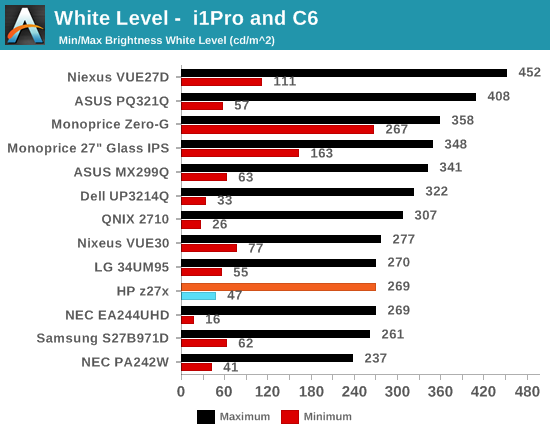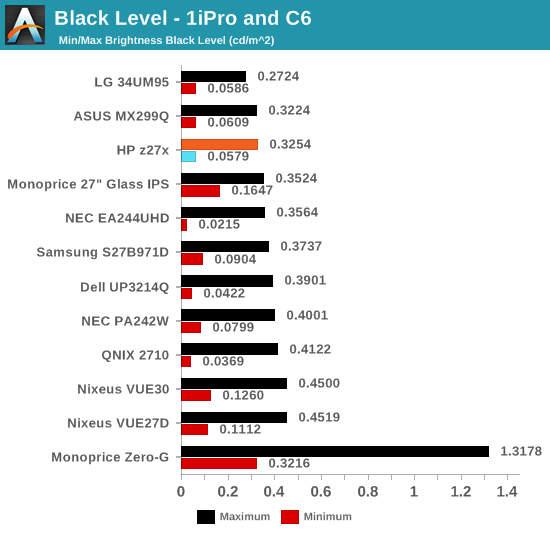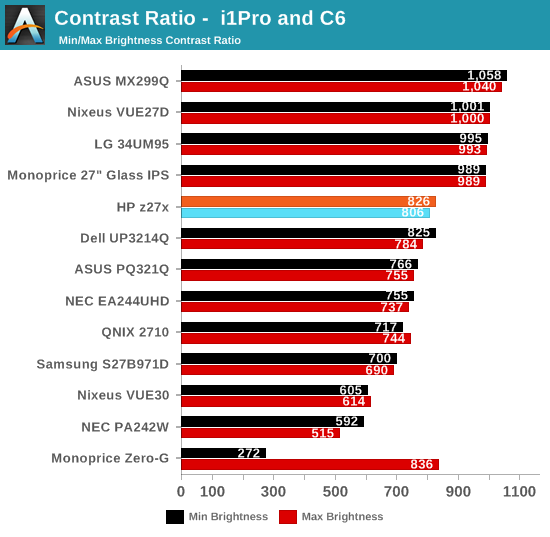HP z27x Review
by Chris Heinonen on December 2, 2014 4:00 PM ESTWith the backlight set to maximum, you only get 269 cd/m2 of brightness from the HP z27x. Many displays can go much brighter, but the z27x is meant to be used in more of a professional, production environment. Bright overhead lighting or direct sunlight are not going to be as much of a problem here, so you don’t need 350-400 cd/m2 to try to overcome those issues. It won’t work as well for such environments but you shouldn’t be using a $1,500 monitor in those situations either. At minimum brightness we get 47 cd/m2 of brightness. This is low enough for any real world use without going down to the unusable levels that some displays do.

Black levels are consistent with other professional level IPS panels. They are not as dark as an IPS panel can be, as the recent Retina iMac would demonstrate, but other performance aspects are more important than absolute black. The z27x would be improved by a better black level, but most of its target users should be fine with what it achieves.

The resulting contrast ratios here are around 815:1, or average for an IPS panel. There is no backlight control or anything else to enhance these beyond what they are. Under 1,000:1 is beginning to be not so great for an IPS panel, though almost all professional panels from NEC or others also fall into this range. It might seem strange that a professional display would value black levels less than a consumer one, but having an even gamma curve with visible shadow details is more important and contrast ratio can be sacrificed to achieve that,

The HP z27x data so far goes along with what I expect from a professional level display. Consumers that plan to watch movies and play games on their display might be happier with a display with improved contrast ratios. Professionals after different performance measures should be happy with the z27x numbers.










47 Comments
View All Comments
bobbozzo - Tuesday, December 2, 2014 - link
Hi,It wasn't clear to me which is preferred - using (renting?) a Klein K-10A colorimeter and doing the self-calibration, or doing software calibration?
Thanks for the article
cheinonen - Tuesday, December 2, 2014 - link
Doing it inside the monitor is best, as you don't need to worry about the PC LUT being correct, it will just be accurate on any computer hooked up to it.Samus - Tuesday, December 2, 2014 - link
A worthy successor to my Dreamcolor LP2480, moar resolution and USB 3.0!Oubadah - Sunday, December 21, 2014 - link
Plus no A-TW Polarizer and inferior backlight array. This monitor isn't in the same class as the last gen Dreamcolor. Not to mention it's bugs and abysmal quality control. http://www.liftgammagain.com/forum/index.php?threa... I wouldn't touch this monitor with a barge pole at the moment.tyger11 - Tuesday, December 2, 2014 - link
When are we going to see monitors with HDMI 2.0 and DP 1.3?cheinonen - Tuesday, December 2, 2014 - link
Once we have chipsets. The issue with HDMI 2.0 is that all the current HDMI 2.0 chipsets with the full bandwidth don't have HDCP 2.2 as well. The HDCP 2.2 chipsets only use a subset of HDMI 2.0 and so they can't send as much data. Hopefully at CES next month we'll see products announced using new chipsets.wolrah - Wednesday, December 3, 2014 - link
Does HDCP actually matter to PC users? Aside from legitimate playback of Bluray/HD-DVD content what else on a PC ever gave a shit about it? I think iTunes did at one point, no idea if it still does.I mean there are technically roles a PC can fill for which it matters, but personally even among those I know who have BD-ROM drives in their PCs (a slim number, optical drives altogether are a dying breed) I don't know anyone who actually uses their PC to watch movies from disc. Anyone who uses discs uses a hardware player or more often a console, and anyone who uses a PC just sources from the internet in one way or another.
For TVs HDCP is a big deal, but for a computer monitor I'm finding it hard to care.
cheinonen - Wednesday, December 3, 2014 - link
I don't know that it's a big deal for straight PC usage, but it's also likely to upset people if they buy an HDMI 2.0 monitor, only to discover when they try to hook up their other 4K devices to it that they won't play back a 4K image. Since the chips are expected to be at CES, I don't think we will have to wait too long for them and IMO I'd rather have a display that can do that, without needing MST for a 60Hz refresh rate, than have a monitor today that will be out of date that fast.chaos215bar2 - Wednesday, December 3, 2014 - link
On a Mac, at least, iTunes most certainly still does care about HDCP. Even Netflix manages to check it when using the HTML5 player. HDCP may be silly, but it's still important if you want to watch videos on your computer without the hassle of stripping DRM.DanNeely - Thursday, December 4, 2014 - link
As of about 8 months ago (last time I tried using it) Amazon Instant Video also required HDCP for higher quality streams.